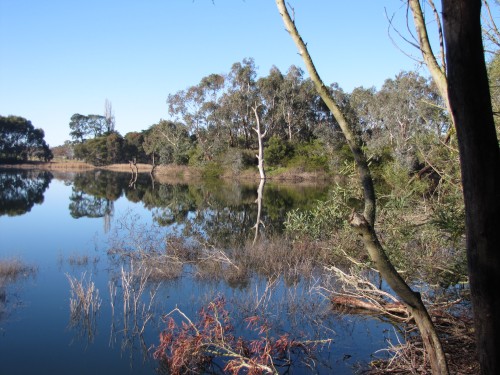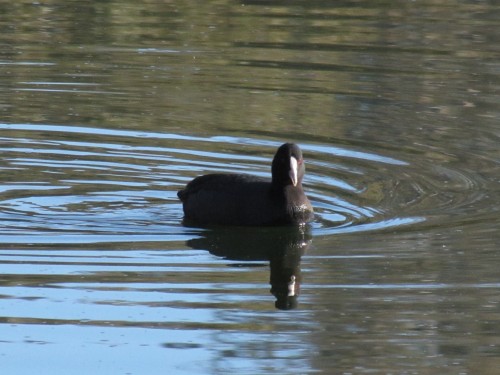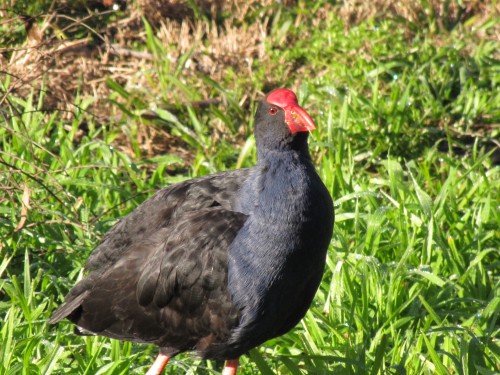Australian Shoveler at Clare, South Australia
On Sunday I went for a short walk from my daughter’s home in Clare. At the end of a nearby street I came to an open area surrounding the local sewage treatment plant. I used to visit this area from time to time when we lived in Clare about 25 years ago. I had not visited the area again since.
Sewage Treatment Plant
Sewage treatment plants are very interesting places. They tend to attract quite a variety of birds. These, in turn, attract birders like me. On this occasion I was not disappointed. There were the usual suspects like Masked Lapwings along the edges, Pacific Black Ducks, Grey and Chestnut Teal and several Australasian Grebes. I was not surprised to see about twenty Pink Eared Ducks as well because I have often seen this species on Inchquin Lake a few hundred metres away. I was delighted to see about a dozen Black Swans as I can’t recall having seen them on the lake. Perhaps the lake, with its nearby picnic area on one side and golf course on the other, is too populated and noisy.
Australian Shoveler
One species I hoped to see was the Australian Shoveler. I had not observed this species of duck for over twenty years and only on a handful of occasions at that. I have only ever seen it on one occasion elsewhere so I was very pleased to record it again here. In the past I can only recall seeing up to about five individuals. This time there must have been over thirty present. It made me wonder if this species is a regular visitor, or is it actually a breeding resident species. I must remember to check it out more regularly as I visit my daughter.
Other birds seen
Other birds heard or seen nearby include Australian Magpie, Magpie-lark, Musk Lorikeet, Galah, Crimson Rosella, Willie Wagtail, Noisy Miner, Red Wattlebird, White Plumed Honeyeater and New Holland Honeyeater. On the nearby Inchquin Lake I observed Blue Billed Ducks, Wood Ducks and four Black Fronted Dotterels.
Spoonbills of a different kind
I have been doing some searching on the internet over the Easter weekend. Last night I found a wonderful birding blog written by American birder Laura Erickson. She has written hundreds of pages about American birds and so her blog is very educational – and interesting. (Sometimes those two phrases don’t go together.)
Photo Gallery
The strength of her blog, in my opinion, is in her photo gallery. She has hundreds of beautiful bird photos. I was particularly impressed with her photos of the Roseate Spoonbills. They are so much more beautiful than our Australian spoonbills – which are lovely in their own right. It is such a stunning bird I feel like going out, buying a plane ticket to America and searching out this wonderful bird for myself.
Laura’s site called Birder Blog can be found by clicking here.
Yellow Billed Spoonbill
Today I needed to visit someone in a part of the city I don’t normally frequent. This was quite close to Long Island Reserve, so I took five minutes out of my busy schedule to check out the birds there, seeing I hadn’t visited that reserve for about a year – maybe more.
Long Island Reserve
Long Island is a long island (funny about that) in the middle of the River Murray just down stream from the CBD of Murray Bridge, South Australia. It has extensive lawned areas for picnics, a small sandy beach, a jetty and a boat ramp. It is a popular place for water skiers and boating enthusiasts. The car park has been deliberately widened to cater for boat trailers.
Birdwise there was nothing much to report. Several Magpie Larks feeding on the lawn, a flock of about 40 Silver Gulls sheltering from the wind and about 6 Straw Necked Ibis feeding in an adjacent grassy area. Wasn’t even worth getting out of the car.
Rocky Gully Wetlands revisited
On my way home I made a slight deter past the Rocky Gully Wetlands. Last week I observed Royal Spoonbills there for the first time. Today it was a solitary Yellow Billed Spoonbill next to a White Faced Heron. Always nice to see spoonbills – and so funny the way they feed, swishing that odd-shaped bill through the mud.
Sadly – I didn’t have my camera with me. (Sigh)
Kakadu & Arnhem Land – a DVD review
I have subscribed to the Australian Geographic magazine for many years and enjoy the interesting and varied articles about Australia that they contain. I think that the photography contained in these magazines is brilliant. I particularly enjoy any photos and articles about birds, plants and other aspects of our wonderful flora and fauna.
Special DVD
The last two issues of the magazine have included a bonus DVD produced and presented by Sorrel Wilby. The current issue, which arrived a few days ago, included number 2 in the series and is titled “Kakadu & Arnhem Land.” It covers some of the flora and fauna of this wonderful region of the Northern Territory of Australia. Its main strength, however, is in the coverage of the culture of the local Aboriginal people. The commentary gives one a good introduction to the deep spiritual connection between the Aboriginal culture and the land we know as Kakadu.
The birds and plants of Kakadu
While this new DVD does not specifically cover the vast range of birds and plants present in the Kakadu and Arnhem Land region, it does feature quite a number of species, especially water birds, in several sections. The opening few minutes show quite an array of the birds one can see there. Several species of plants and insects are also featured but this is just a taste of the enormous range of flora and fauna that has been recorded there.
Bonus feature
A special extra bonus on the DVD is a 4 minute feature on photographer David Hancock. He has specialised in photographing the Kakadu and Arnhem Land area. His latest article “Buffalo Rising” – about buffaloes in the Northern Territory – is included in the current issue of the magazine.
Conclusion
This beautiful new DVD will certainly give people a taste of what is to be seen in the Kakadu area. The photography is beautiful and inspiring. The introduction to the spiritual and cultural heritage of the region is interesting. Overall, it will inspire people who have never visited the region to put Kakadu on their “must see” list. Those who have had the delight of already experiencing the region will feel the urge to return.
Birders wanting lots of photos of birds may be disappointed. I would like to have seen more birds featured – but then, this was not intended as just another bird DVD. Its intention was to paint a broader picture, and has indeed, succeeded in doing so.
The main section runs for 52 minutes.
UPDATE January 4th 2008: Back copies of this DVD and others in the same series are currently available from the magazine by ringing 1300 555 176 Monday to Friday during office hours (Australian time).
Update Nov 2013: I’m not sure if these DVDs are still available.


